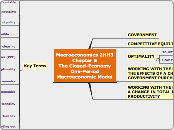Macroeconomics 2HH3Chapter 5The Closed-EconomyOne-PeriodMacroeconomic Model
GOVERNMENT
COMPETITIVE EQUILIBRIUM
OPTIMALITY
SOURCES OF SOCIAL INEFFICIENCIES
HOW TO USE THE MODEL
WORKING WITH THE MODEL:THE EFFECTS OF A CHANGE INGOVERNMENT PURCHASES
WORKING WITH THE MODEL:A CHANGE IN TOTAL FACTORPRODUCTIVITY
INTERPRETATION OF THE MODEL'SPREDICTIONS
Key Terms
closed economy
an economy that does not trade withthe rest of the world
open economy
an economy that trades with the rest of the world
public goods
goods that are difficult or impossible for the privatesector to provide, for example, national defence
exogenous variable
a variable determined outside the model
endogenous variable
a variable that the model determines
government budget constraints
an equation describing the sources and uses ofgovernment revenues
fiscal policy
the government choices over government expenditures,taxes, tranfers, and government borrowing
competitive equilibrium
a state of the economy in which prices and quantitiesare such that the behaviour of price-taking consumersand firms are consistent
market clearing
when supplyequals demand in a particularmarket or markets
production possibilities fortier (PPF)
the boundry of a set that describes what consumptionbundles can be technologically exchanged for another
Pareto-optimality
A state of the economy that cannot be improved onby making on consumer better off without makinganother worse off
first fundamental theorem of welfare economics
results stating that, under certain conditions, a competitive equilibriumis Pareto-Optimal
second fundamental theorem of welfare economics
result stating that, under certain conditions, a Paretooptimum is a competive equilibrium
externality
the effect an action taken by an economic agent has onanother economic agent or agents, where the agent performingthe action does not take into account this effect on others
distortion tax
a tax, such as an income tax, that creates a difference betweenthe effective prices faced by buyers and sellers of some good
crowding out
the displacement of private expenditures by governmentpurchases
long run
typically describes macroeconomic effects that occur beyond a years time
short run
typically describes macroeconomic effect that occur within a year'stime
real business cycle theory
a theory postulating that the primary cause of aggregate fluctuationsis fluctions in total factor productivity
intertemporal substitution of labour
the substitution of labour over time by a worker in responseto movements in real wages
